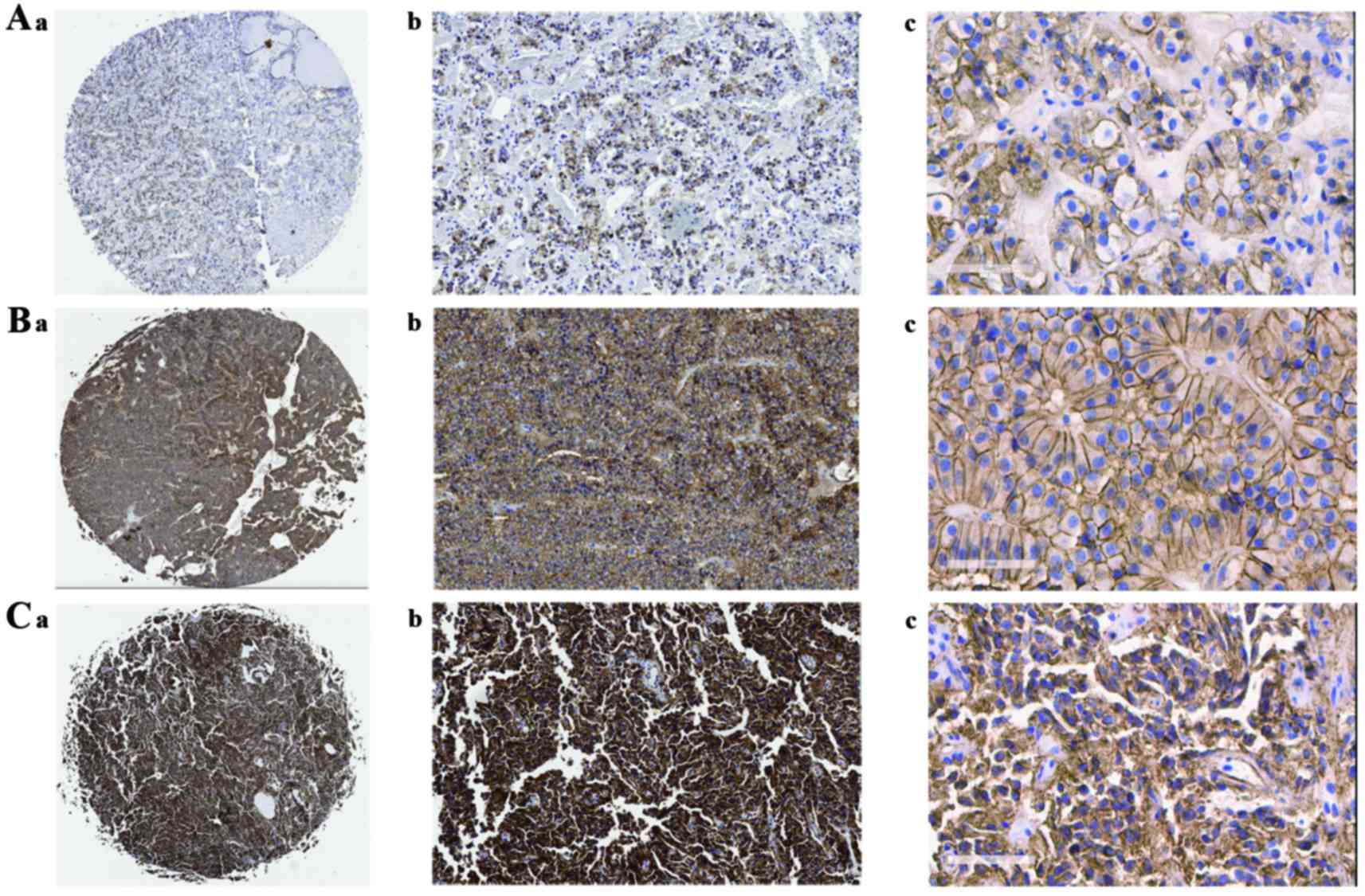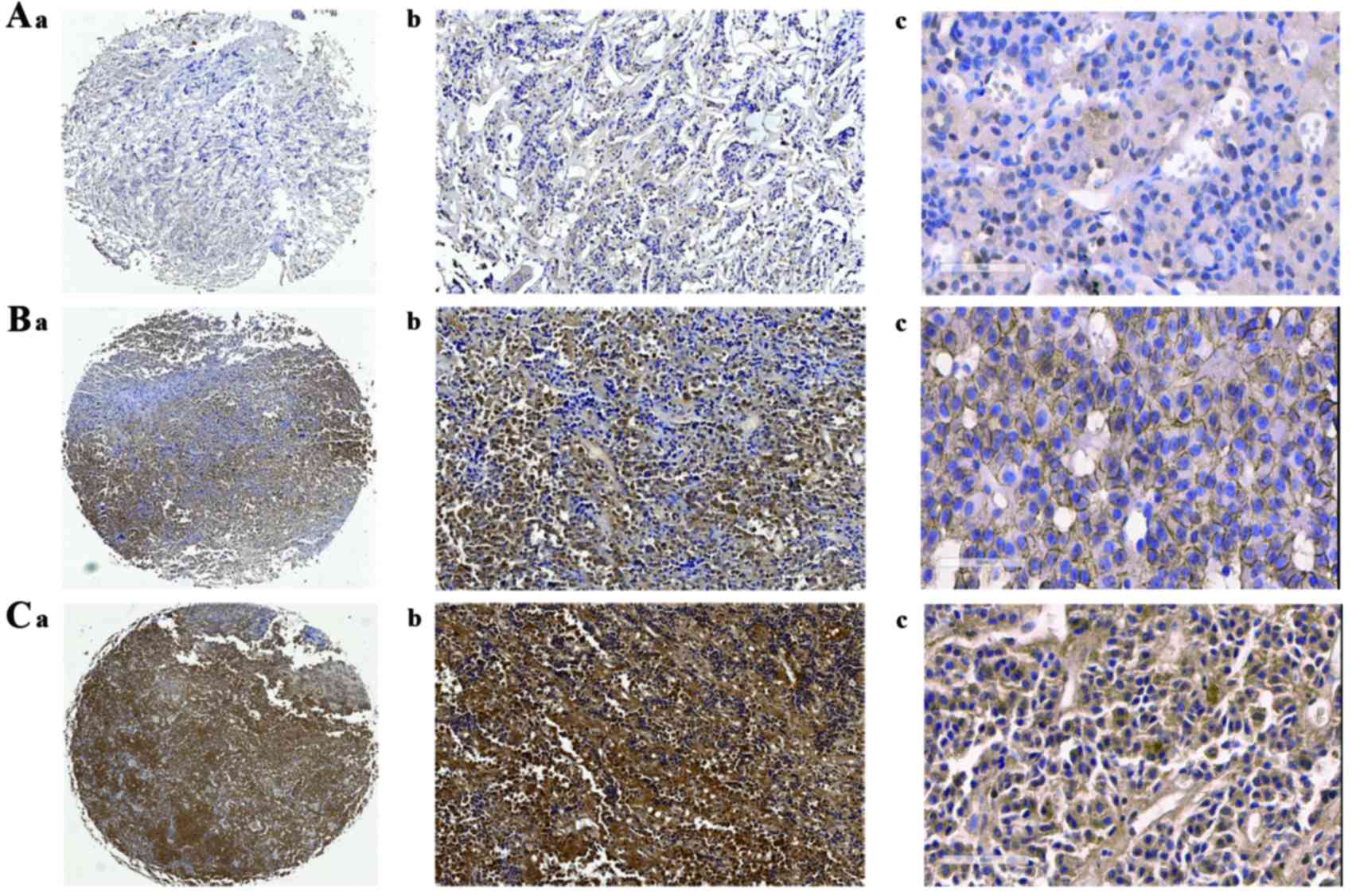|
1
|
Scheithauer BW, Gaffey TA, Lloyd RV, Sebo
TJ, Kovacs KT, Horvath E, Yapicier O, Young WF Jr, Meyer FB, Kuroki
T, et al: Pathobiology of pituitary adenomas and carcinomas.
Neurosurgery. 59:341–353. 2006. View Article : Google Scholar
|
|
2
|
Saeger W, Lüdecke DK, Buchfelder M,
Fahlbusch R, Quabbe HJ and Petersenn S: Pathohistological
classification of pituitary tumors: 10 years of experience with the
german pituitary tumor registry. Eur J Endocrinol. 156:203–216.
2007. View Article : Google Scholar : PubMed/NCBI
|
|
3
|
Brochier S, Galland F, Kujas M, Parker F,
Gaillard S, Raftopoulos C, Young J, Alexopoulou O, Maiter D and
Chanson P: Factors predicting relapse of nonfunctioning pituitary
macroadenomas after neurosurgery: A study of 142 patients. Eur J
Endocrinol. 163:193–200. 2010. View Article : Google Scholar : PubMed/NCBI
|
|
4
|
Clevers H and Nusse R: Wnt/beta-catenin
signaling and disease. Cell. 149:1192–1205. 2012. View Article : Google Scholar : PubMed/NCBI
|
|
5
|
Herr P, Hausmann G and Basler K: WNT
secretion and signalling in human disease. Trends Mol Med.
18:483–493. 2012. View Article : Google Scholar : PubMed/NCBI
|
|
6
|
Polakis P: The many ways of Wnt in cancer.
Curr Opin Genet Dev. 17:45–51. 2007. View Article : Google Scholar : PubMed/NCBI
|
|
7
|
Jin T, George Fantus I and Sun J: Wnt and
beyond Wnt: Multiple mechanisms control the transcriptional
property of beta-catenin. Cell Signal. 20:1697–1704. 2008.
View Article : Google Scholar : PubMed/NCBI
|
|
8
|
Michl P, Barth C, Buchholz M, Lerch MM,
Rolke M, Holzmann KH, Menke A, Fensterer H, Giehl K, Löhr M, et al:
Claudin-4 expression decreases invasiveness and metastatic
potential of pancreatic cancer. Cancer Res. 63:6265–6271.
2003.PubMed/NCBI
|
|
9
|
Sodir NM, Swigart LB, Karnezis AN, Hanahan
D, Evan GI and Soucek L: Endogenous myc maintains the tumor
microenvironment. Genes Dev. 25:907–916. 2011. View Article : Google Scholar : PubMed/NCBI
|
|
10
|
Wright JB, Brown SJ and Cole MD:
Upregulation of c-MYC in cis through a large chromatin loop linked
to a cancer risk-associated single-nucleotide polymorphism in
colorectal cancer cells. Mol Cell Biol. 30:1411–1420. 2010.
View Article : Google Scholar : PubMed/NCBI
|
|
11
|
Lin CY, Lovén J, Rahl PB, Paranal RM,
Burge CB, Bradner JE, Lee TI and Young RA: Transcriptional
amplification in tumor cells with elevated c-myc. Cell. 151:56–67.
2012. View Article : Google Scholar : PubMed/NCBI
|
|
12
|
Wu Y, Bai J, Li Z, Wang F, Cao L, Liu C,
Yu S, Yu G and Zhang Y: Low expression of secreted frizzled-related
protein 4 in aggressive pituitary adenoma. Pituitary. 18:335–342.
2015. View Article : Google Scholar : PubMed/NCBI
|
|
13
|
Formosa R, Gruppetta M, Falzon S, Santillo
G, DeGaetano J, Xuereb-Anastasi A and Vassallo J: Expression and
clinical significance of Wnt players and survivin in pituitary
tumours. Endocr Pathol. 23:123–131. 2012. View Article : Google Scholar : PubMed/NCBI
|
|
14
|
Hong L, Wu Y, Feng J, Yu S, Li C, Wu Y, Li
Z, Cao L, Wang F and Zhang Y: Overexpression of the cell adhesion
molecule claudin-9 is associated with invasion in pituitary
oncocytomas. Hum Pathol. 45:2423–2429. 2014. View Article : Google Scholar : PubMed/NCBI
|
|
15
|
Wilson CB: A decade of pituitary
microsurgery. The Herbert Olivecrona lecture. J Neurosurg.
61:814–833. 1984. View Article : Google Scholar : PubMed/NCBI
|
|
16
|
Knosp E, Steiner E, Kitz K and Matula C:
Pituitary adenomas with invasion of the cavernous sinus space: A
magnetic resonance imaging classification compared with surgical
findings. Neurosurgery. 33:610–617. 1993. View Article : Google Scholar : PubMed/NCBI
|
|
17
|
Rosenquist M: 14-3-3 proteins in
apoptosis. Braz J Med Biol Res. 36:403–408. 2003. View Article : Google Scholar : PubMed/NCBI
|
|
18
|
Kopp C, Theodorou M, Poullos N, Astner ST,
Geinitz H, Stalla GK, Meyer B, Molls M, Nieder C and Grosu AL:
Fractionated stereotactic radiotherapy in the treatment of
pituitary adenomas. Strahlenther Onkol. 189:932–937. 2013.
View Article : Google Scholar : PubMed/NCBI
|
|
19
|
Monga SP: β-Catenin signaling and roles in
liver homeostasis, injury, and tumorigenesis. Gastroenterology.
148:1294–1310. 2015. View Article : Google Scholar : PubMed/NCBI
|
|
20
|
Cohen JB, Geyer SM, Lozanski G, Zhao W,
Heerema NA, Hall NC, Nagar VA, Hemminger JA, Jones JA, Porcu P, et
al: Complete response to induction therapy in patients with
myc-positive and double-hit non-Hodgkin lymphoma is associated with
prolonged progression-free survival. Cancer. 120:1677–1685. 2014.
View Article : Google Scholar : PubMed/NCBI
|
|
21
|
Prensner JR, Chen W, Han S, Iyer MK, Cao
Q, Kothari V, Evans JR, Knudsen KE, Paulsen MT, Ljungman M, et al:
The long non-coding RNA PCAT-1 promotes prostate cancer cell
proliferation through cMyc. Neoplasia. 16:900–908. 2014. View Article : Google Scholar : PubMed/NCBI
|
|
22
|
Lin YU, Wu T, Yao Q, Zi S, Cui L, Yang M
and Li J: LGR5 promotes the proliferation of colorectal cancer
cells via the Wnt/β-catenin signaling pathway. Oncol Lett.
9:2859–2863. 2015.PubMed/NCBI
|
|
23
|
Chiurillo MA: Role of the Wnt/β-catenin
pathway in gastric cancer: An in-depth literature review. World J
Exp Med. 5:84–102. 2015. View Article : Google Scholar : PubMed/NCBI
|
|
24
|
Soutto M, Romero-Gallo J, Krishna U,
Piazuelo MB, Washington MK, Belkhiri A, Peek RM Jr and El-Rifai W:
Loss of TFF1 promotes Helicobacter pylori-induced β-catenin
activation and gastric tumorigenesis. Oncotarget. 6:17911–17922.
2015. View Article : Google Scholar : PubMed/NCBI
|
|
25
|
Ho SK, Thike AA, Cheok PY, Tse GM and Tan
PH: Phyllodes tumours of the breast: The role of CD34, vascular
endothelial growth factor and β-catenin in histological grading and
clinical outcome. Histopathology. 63:393–406. 2013. View Article : Google Scholar : PubMed/NCBI
|
|
26
|
Simpson DJ, Hibberts NA, McNicol AM,
Clayton RN and Farrell WE: Loss of pRb expression in pituitary
adenomas is associated with methylation of the RB1 CpG island.
Cancer Res. 60:1211–1216. 2000.PubMed/NCBI
|
|
27
|
Lee EH, Kim KH, Kwon JH, Kim HD and Kim
YZ: Results of immunohistochemical staining of cell-cycle
regulators: The prediction of recurrence of functioning pituitary
adenoma. World Neurosurg. 81:563–575. 2014. View Article : Google Scholar : PubMed/NCBI
|
|
28
|
O'Sullivan EP, Woods C, Glynn N, Behan LA,
Crowley R, O'Kelly P, Smith D, Thompson CJ and Agha A: The natural
history of surgically treated but radiotherapy-naïve nonfunctioning
pituitary adenomas. Clin Endocrinol (Oxf). 71:709–714. 2009.
View Article : Google Scholar : PubMed/NCBI
|
|
29
|
Wang EL, Qian ZR, Rahman MM, Yoshimoto K,
Yamada S, Kudo E and Sano T: Increased expression of HMGA1
correlates with tumour invasiveness and proliferation in human
pituitary adenomas. Histopathology. 56:501–509. 2010. View Article : Google Scholar : PubMed/NCBI
|
|
30
|
Dallapiazza RF, Grober Y, Starke RM, Laws
ER Jr and Jane JA Jr: Long-term results of endonasal endoscopic
transsphenoidal resection of nonfunctioning pituitary
macroadenomas. Neurosurgery. 76:42–53. 2015. View Article : Google Scholar : PubMed/NCBI
|
|
31
|
Chang EF, Zada G, Kim S, Lamborn KR,
Quinones-Hinojosa A, Tyrrell JB, Wilson CB and Kunwar S: Long-term
recurrence and mortality after surgery and adjuvant radiotherapy
for nonfunctional pituitary adenomas. J Neurosurg. 108:736–745.
2008. View Article : Google Scholar : PubMed/NCBI
|











